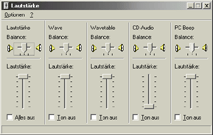The Internal Mixer

The Internal Mixer on the DSP24 series cards represents basically an additional soundcard which has been 'added' to the audiocard functions. You can use the this section to play Windows sounds or the metronome from a sequenzer, also you could use it for consumer applications such as games, speech recognition software or for internet phone usage. Since the Internal Mixer even supports DirectSound, you can use it also for some conventional software synthesizer applications. To control this section, the Windows mixer (SNDVOL32.EXE) is used. The Internal Mixer is represented by a AC-97 codec chip that is on your DSP24 series PCI card. AC-97 has been defined as standard by Intel for consumer audio applications on modern PCs. The AC-97 codec ST Audio is using works with a 18bit ADC, a 18bit DAC and an analog mixer.
Note that you would never use the Internal Mixer for high quality recording or playback for music production. This means: if you have no need for consumer audio applications (as mentioned above) or if you are using a separate consumer soundcard in your PC for such applications, you would never use the Internal Mixer and you can stop reading this text now. The Internal Mixer is a nice addition to the main function set of the DSP24 series PCI card - not more, not less.
You call the Internal Mixer via External Links [1] (DSP24, DSP24 MK II, DSP24 ADAT) or the Output Mixer [2] (DSP24 Value, DSP24 MEDIA 7.1). The Windows mixer window that is displayed above will be displaxed then. The software shows different channels:
| Master | Controls the Master output volume of the Internal Mixer. This signal is sent out via the 1/8" output on the PCI-card. |
| Wave | Controls the Wave volume. The signal you play via the MME device ADSP24 Int. WaveOut is controlled here. Signals from pro audio applications (using ASIO or GSIF for example) are not sent controlled by the Internal Mixer of course. By default this device is selected as output for Windows system sounds under Control Panel > Multimedia > Audio > Prefered playback device. Of course you can change this if you do not want the Windows system sounds to be played via the 1/8" output of the PCI-card. |
| Mic | Controls the volume of the 1/8" mic input on the DSP24 PCI card. This input is not available on the DSP24 Value, DSP24 MK II and DSP24 ADAT. |
| Line In | Controls the volume of the 1/8" line input on the DSP24 PCI card. This input is not available on the DSP24 Value, DSP24 MK II and DSP24 ADAT. |
| CD In | Controls the volume of the internal analog CD input (3-pin). |
| Aux | Controls the volume of the internal analog Aux input (3-pin). |
You can also record the signal form the Internal Mixer. Recording with the AC-97 section of the card might be interesting for special applications that depend on consumer soundcard functionality (analog mixing, standard windows mixing controls, etc.) like speech recognition software or internet phone applications. To record the signal you have selected here, the MME device ADSP24 Int. Audio Device must be used. You can select the record source via Options > Properties > Record in the record mixer window.
Note: older drivers for Windows 9x/Me had a separate application that was used to control the Internal Mixer functions. To simplify the user interface and because of compatibility issues, this program is no longer used and has been replaced by the standard Windows mixer (SNDVOL32.EXE).
|
|
last updated: 07/11/2002 author: Claus Riethmüller
|
|
| References to other documents or external websites |
|
[1]
How to use External Links
(DSP24, DSP24 MK II, DSP24 System III, DSP2000 C-Port), ST Audio Knowledge
Base
[1] How to use External Links (DSP24 ADAT), ST Audio Knowledge Base [2] How to use the Output Mixer (DSP24 Value), ST Audio Knowledge Base [2] How to use the Output Mixer (DSP24 MEDIA 7.1), ST Audio Knowledge Base |
|
|